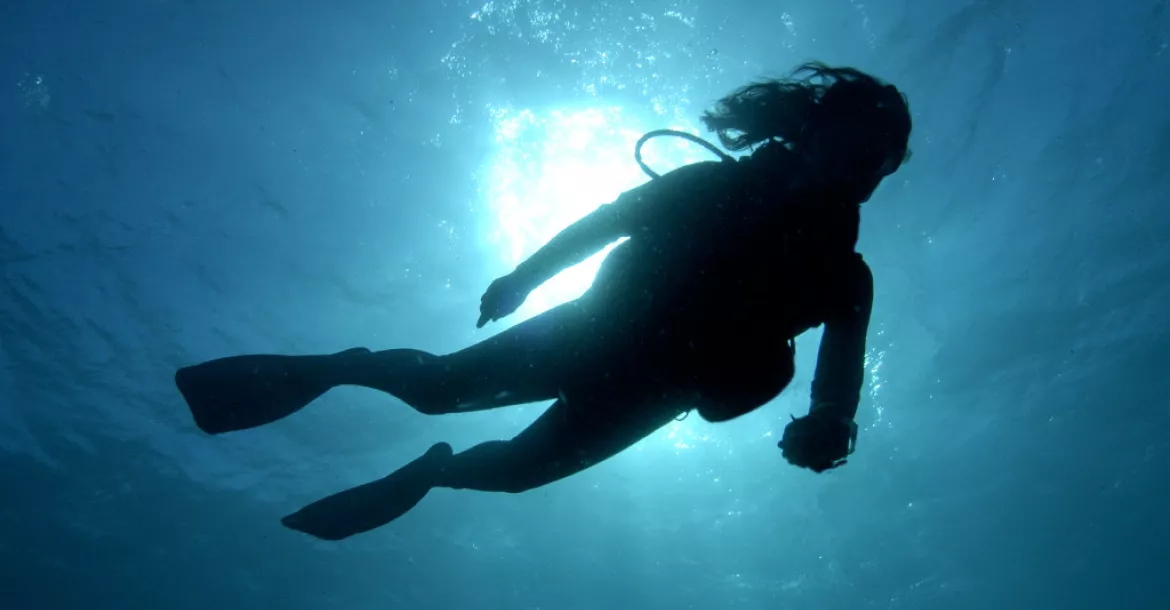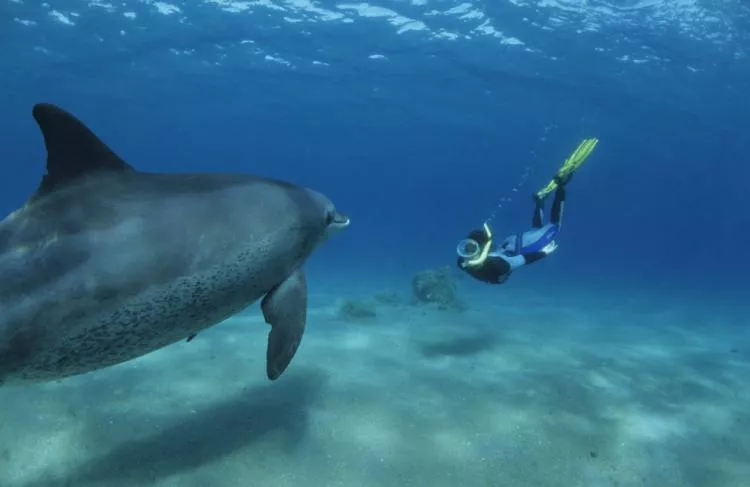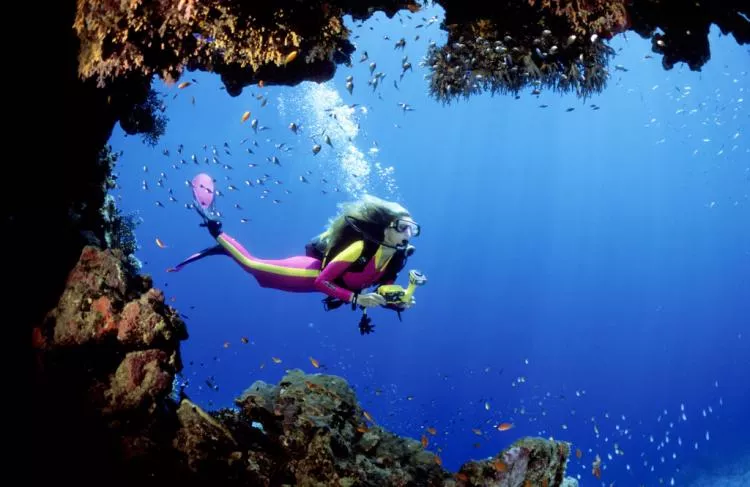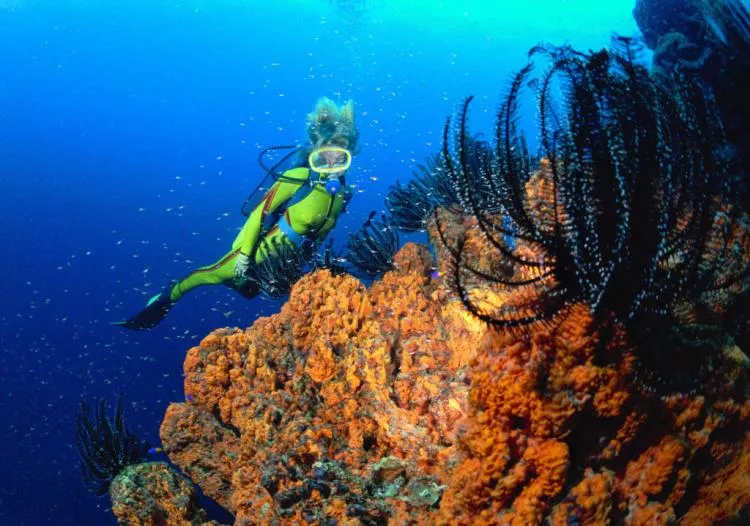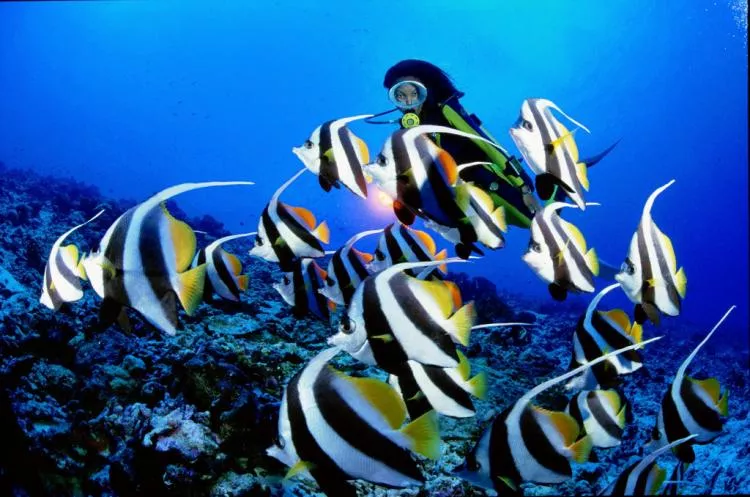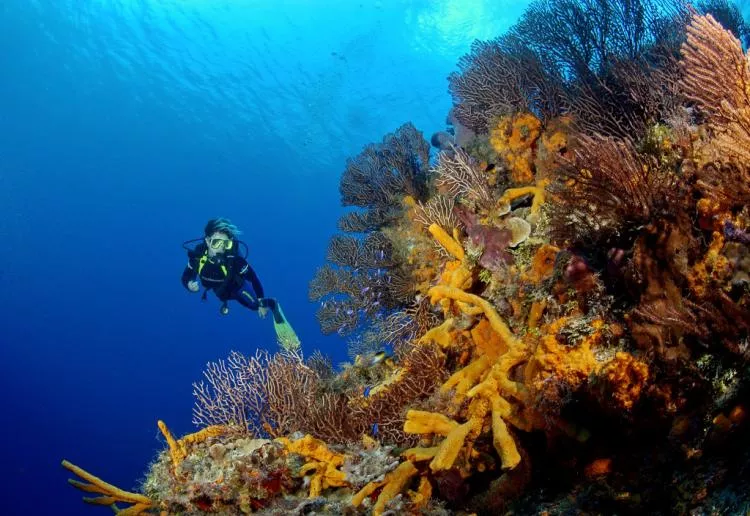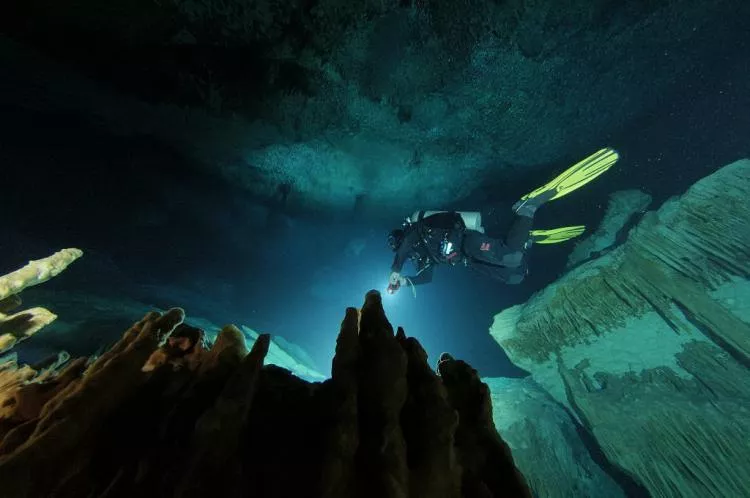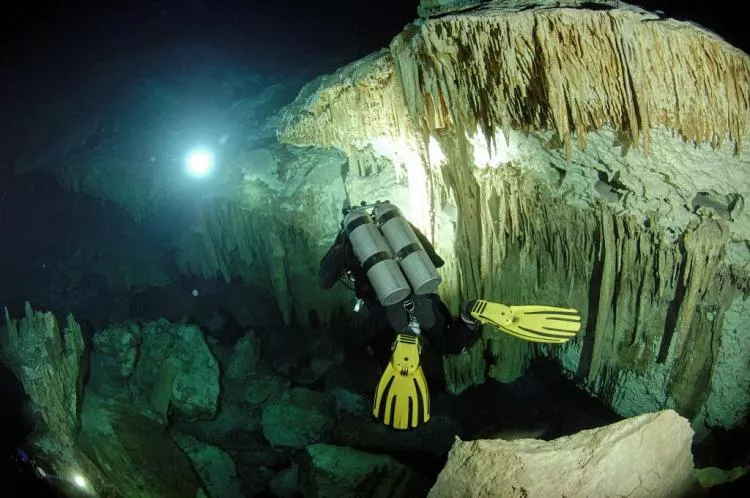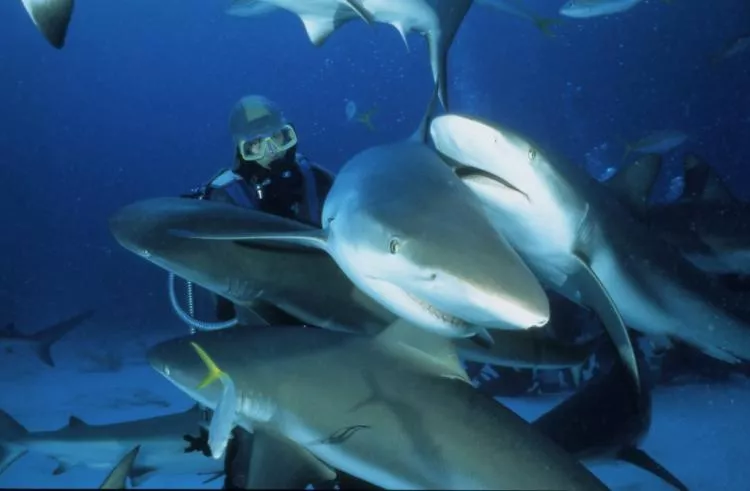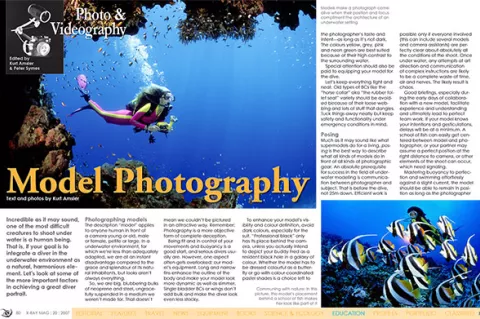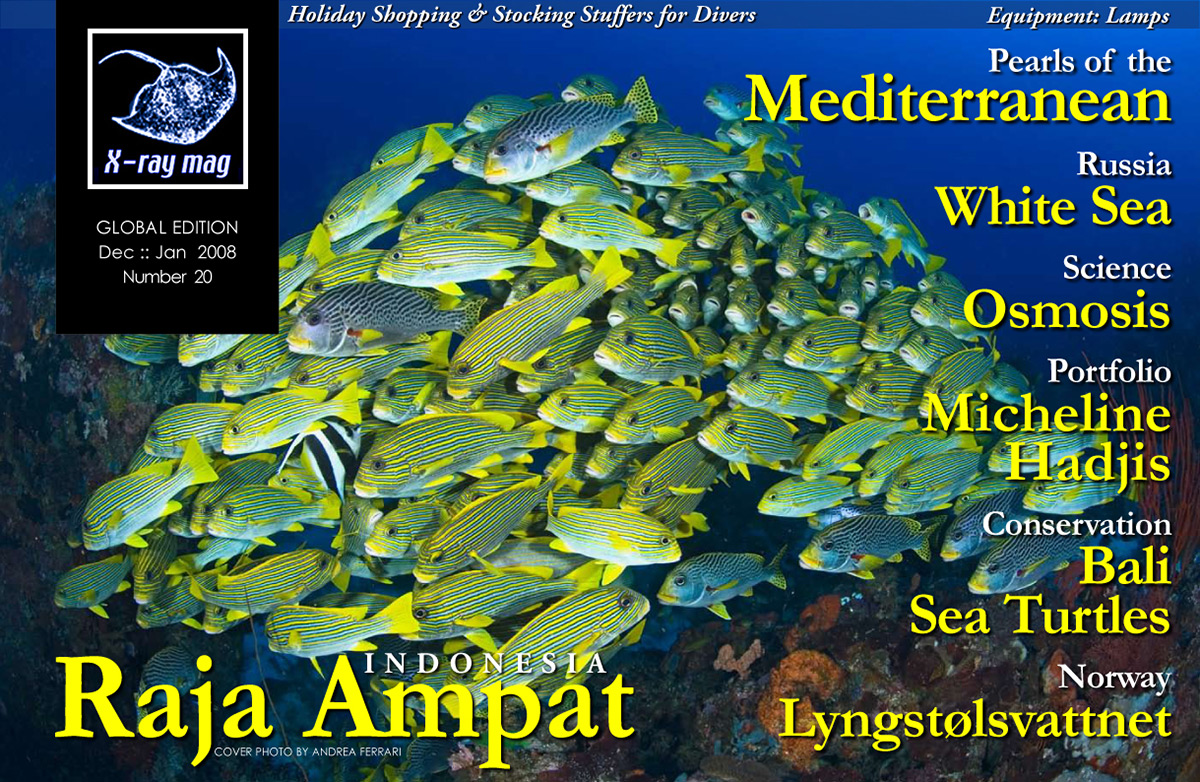Incredible as it may sound, one of the most difficult creatures to shoot under water is a human being. That is, if your goal is to integrate a diver in the underwater environment as a natural, harmonious element. Let’s look at some of the more important factors in achieving a great diver portrait.
Contributed by
Photographing models
The description “model” applies to anyone human in front of a camera young or old, male or female, petite or large. In a underwater environment, for which we’re less than adequately adapted, we are at an instant disadvantage compared to the grace and splendour of its natural inhabitants, but looks aren’t always everything.
So, we are big, blubbering bulks of neoprene and steel, ungracefully suspended in a medium we weren’t made for. That doesn’t mean we couldn’t be pictured in an attractive way. Remember: Photography is a more objective form of complete deception.
Being fit and in control of your movements and buoyancy is a good start, and serious divers usually are. However, one aspect often gets overlooked: our model’s equipment. Long and narrow fins enhance the outline of the body and make your model look more dynamic as well as slimmer. Single bladder BCs or wings don’t add bulk and make the diver look even less stocky.
To enhance your model’s visibility and colour definition, avoid dark colours, especially for the suit. “Professional black” only has its place behind the camera, unless you actually intend to depict your buddy Fred as a resident black hole in a galaxy of colour. Whether the model has to be dressed colourful as a butterfly or go with colour coordinated pastel shades is a choice left to the photographer’s taste and intent—as long as it’s not dark. The colours yellow, grey, pink and neon green are best suited because of their high contrast to the surrounding water.
Special attention should also be paid to equipping your model for the dive.
Let’s keep everything tight and neat. Old types of BCs like the “horse collar” aka “the rubber toilet seat” variety should be avoided because of their loose webbing and lots of stuff that dangles. Tuck things away neatly but keep safety and functionality under emergency conditions in mind.
Posing
Much as it may sound like what supermodels do for a living, posing is the best way to describe what all kinds of models do in front of all kinds of photographic gear. An absolute prerequisite for success in the field of underwater modelling is communication between photographer and subject. That is before the dive, not 25m down. Efficient work is possible only if everyone involved (this can include several models and camera assistants) are perfectly clear about absolutely all the conditions of the shoot.
Once under water, any attempts at art direction and communication of complex instructions are likely to be a complete waste of time, air and nerves. The likely result is chaos.
Good briefings, especially during the early days of collaboration with a new model, facilitate experience and understanding and ultimately lead to perfect team work. If your model knows your intentions and gesticulations, delays will be at a minimum. A school of fish can easily get centered between model and photographer, or your partner may assume a perfect position at the right distance to camera, or other elements of the shoot can occur, which need signaling.
Mastering buoyancy to perfection and swimming effortlessly against a slight current, the model should be able to remain in position as long as the photographer takes to complete a series. Holding on to coral or bearing down on them is completely “verboten”. Both partners need to be conscious of the environment and act accordingly.
And naturally, as in general photography, the model should never look straight at the lens and assume a natural, plausible posture. Point a flashlight or draw the on-lookers attention to the main subject element by clearly looking at it, head posture and all.
Technical aspects
Model photography uses all kinds of lenses at all distances. The trick is to know what to use for which effect. Half body portraits are best shot using 35mm and 28mm focal lengths. The optical distortions resulting from shorter lenses, the super wide angles, would too severely disfigure the human silhouette.
At short range it is advisable to combine this with the use of a flash diffuser - usually a white plastic cap you put over your flash’s reflector to soften the lighting. Diffusers do cut light energy but at short distances it not anything to worry about.
If your aim is to picture the diver in total or integrate your buddy into a landscape shot, the focal length applied cannot be short enough. Angles between 90° and 180° drastically reduces the distance to subject and consequently the diffusion and absorption of flash light. The result is a clearer, better-defined and sharper picture with improved colour definition. To avoid chalky skin tones it is advisable to minimise flash application and use a strobe yielding a colour temperature around 5100° Kelvin.
Vacancy for Aquaman and Mermaid
Professional underwater photography poses even grater challenges to the model as this genre is dominated by reportage style where a series of pictures tells a story. This approach requires a model who can double as camera assistant and is competent in handling the equipment.
What you’re looking for is a photogenic ace diver with a knack for gadgets and considerable carrying capacity. In other words, an advanced aquatic human being capable of hooking up vast arrays of cable and slave strobes, comfortable with multi-dive profiles on air, Nitrox and Trimix and perfectly focused on the intended outcome of your artistic ambition. (Yep, I’m getting carried away!)
But to be more realistic... It helps if your model enjoys diving and is a competent diver.
Photographic experience is an added bonus because the model understands the photographer’s intent and needs better. The model who is also a photographer will make sure their eyes are in the same focal plane as that lion fish, keep perfect diagonals in mind as they swim into the frame or point a light, and are generally more patient—unless they, too, carry a camera.
Experienced models will go one step further, alerting the photographer to a flash gun pointing away from the subject, signal in case of flash failure, or remind you to remove the lens cover from that venerable Nikonos V.
Model tips
- Talking the language of photography; Any person in front of a camera is a model! Depending on the situation and the planned pictures, the photographer decides if a female or male fits better in it.
- A model has to be your regular buddy, or a resort dive master, who does this kind of stuff all the time. Never count on getting good results from asking some random diver on the dive boat to play the model for a few minutes.
- The model should match the underwater environment. Modern diving gear can look quite aesthetic if you shorten straps and tuck the hoses and other dangling items away, so the model doesn’t look like an “octopus”.
- Most of the time, the model swims behind the main subject, and therefore, it is less illuminated by the strobe. If dressed in a black or dark blue wetsuit, the model will disappear in back as a flat object with low contrast. Use bright suits, the best colours are yellow and silver!
- Good diving skills are a prerequisite for both the photographer and the model! Classical diving procedures must be routine and second nature. If there are too many distractions, it ruins the focus and the results will come out accordingly.
- When working with a model or being a model, never forget to be safe. The same rules apply as with any other dive. In many occasions, the model and photographer will be quite far away from each other and perhaps paying attention to a situation full of action—for example, becoming encircled by a large school of jacks or penetrating a wreck from the side. In all these cases, time, air, depth, currents, distance from the boat and other important facts should be observed.
- The photographers “etiquette” in regard to environment must also be reflected in the behaviour of his or her model. A good model is able to hover above the reef, not pump in it, and respect the animals by not touching, chasing and feeding them.
- A photographer’s saying goes: “A good briefing with the model is half the picture!” Underwater, it becomes even more important. Due to the fact that we can’t talk matters through down there, everything has to be discussed beforehand. During the dive, a good way to make the model understand what the photographer has in mind is by demonstrating it, for example swimming along the stern of a wreck, stopping at a particular point and aiming the beam of the torch to a soft coral. The model observes the demonstration from the position the photographer will shoot from.
- Same rule as on land: Models should never look or stare into the camera, except a person in a picture who has to be recognized for some reason. The model must act in a natural way—looking at the main subject, for example a fish. If the model points the beam of a torch or the slave strobe somewhere, the eyes have to be aimed at the same direction.
- The more the model knows about underwater photography, the easier the work becomes and the better the pictures that result. Send your model to a photo workshop to learn the basics. (Your model will surely appreciate it.) Also always discuss the pictures together—perhaps during a nice dinner in an exclusive restaurant.
Published in
- Log in to post comments

